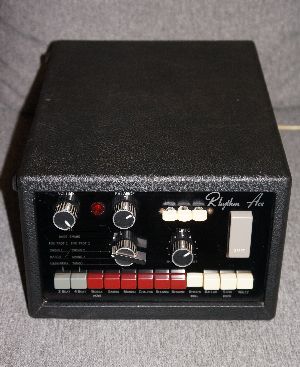 |
Rythm Ace
Rytmeboks med kultstatus fra ca. 1972. FR-6P bygget hos Sakata Shokai i Japan. Pre-Roland model i rigtig flot stand.
Solgt . - I USA er Ebay "prisen" ca. 2400 kr
¤ ¤ ¤
Se lidt tekst fra Roland Cronicle:
Rhythm Ace R-1
Kakehashi developed a prototype of the world’s first fully transistorized, non-automatic percussion instrument. It had no preset patterns but instead sounded individual percussion hits when the buttons were pressed. This made it quite useless for an organist, who was the most likely customer at the time of its release. It was debuted at the Summer NAMM Show in 1964, and while it failed to be commercialized, it did lay the foundations for future designs.
Rhythm Ace FR-1
To meet the market’s desire for an automatic rhythm machine, Kakehashi began to develop a circuit named a diode matrix. This produced rows of pulses that would determine the sound-making position of each instrument in the machine. This culminated in the FR-1 rhythm machine. It hosted 16 preset patterns and four buttons to manually play each instrument voice, which included cymbal, claves, cowbell and bass drum. The rhythm patterns could be combined by pressing multiple rhythm buttons simultaneously, providing over 100 possible rhythm combinations. So popular was the design, it was later adopted by the Hammond Organ Company, who began to incorporate the FR-1 presets into their latest organ models.
Rhythm Ace FR-3
This machine came with 8 different preset sounds, alongside buttons for the 2-beat and 4-beat variations. It also offered individual controls for balance, volume, variation and tempo. The FR-3 would later be reimagined in Kakahashi’s Roland TR Series.
Rhythm Ace FR-4
This device featured 20 presets, from waltz, ballad, cha-cha, beguine, bossa nova, haba-nera and more. The preset rhythms had 2-beat and 4-beat variations, with certain beats accenting different sounds. Combining rhythm patterns gave the user more variation and flexibility. It also offered a balance control, which adjusted the balance between bass drum and cymbal sounds.
Rhythm Ace FR-6
This analog preset drum machine shared the same patterns as the FR-4, with the exception of Slow Rock replacing the Disco preset. The main panel featured individual controls for volume, balance, tempo and variations.
Rhythm Ace FR-6P
This machine came in two different style cases. The FR-6P was identical to the FR-6 but was finished with leatherette rather than wood. The FR-6 design would later be updated and released by Kakahashi in Roland’s TR Series.
|
 |

|
 |
